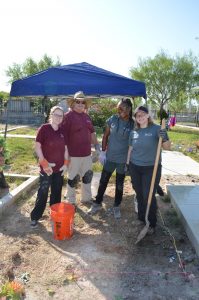We are pleased to announce a new book, based partly upon our fieldwork in the Texas borderlands, being released this fall!
Sociopolitics of Migrant Death and Repatriation: Perspectives from Forensic Science Editors: Latham, Krista E., O’Daniel, Alyson J.
© 2017 Springer International Publishing AG
Summary: As scholars have by now long contended, global neoliberalism and the violence associated with state restructuring provide key frameworks for understanding flows of people across national boundaries and, eventually, into the treacherous terrains of the United States borderlands. The proposed volume builds on this tradition of situating migration and migrant death within broad, systems-level frameworks of analysis, but contends that there is another, perhaps somewhat less tidy, but no less important sociopolitical story to be told here.
Through examination of how forensic scientists define, navigate, and enact their work at the frontiers of US policy and economics, this book joins a robust body of literature dedicated to bridging social theory with bioarchaeological applications to modern day problems.
This volume is based on deeply and critically reflective analyses, submitted by individual scholars, wherein they navigate and position themselves as social actors embedded within and, perhaps partially constituted by, relations of power, cultural ideologies, and the social structures characterizing this moment in history.
Each contribution addresses a different variation on themes of power relations, production of knowledge, and reflexivity in practice. In sum, however, the chapters of this book trace relationships between institutions, entities, and individuals comprising the landscapes of migrant death and repatriation and considers their articulation with sociopolitical dynamics of the neoliberal state.
Table of Contents
Forward by Debra Martin
Preface by Robin Reineke
Part I: Beyond Local Jurisdictions: Science in a Global Web of Relations
Chapter 1 – Introduction by Alyson O’Daniel and Krista E. Latham
Chapter 2 – All that Remains by Adriana Paramo
Chapter 3 – Capitalism and Crisis in Central America by Dawn Paley
Chapter 4 – Naming State Crimes, Naming the Dead: Immigration Policy and “the New Disappeared” in the United States and Mexico by Christine Kovic
Chapter 5 – Loss, Uncertainty and Action: Ethnographic Encounters with Families of the Missing in the Central America-Mexico-US Corridor by Wendy A. Vogt
Chapter 6 – The Geography of Migrant Death: Implications for Policy and Forensic Science by Gabriella Soto and Daniel E. Martínez
Chapter 7 – “Follow the Power Lines Until You Hit a Road:” Contextualizing Humanitarian Forensic Science in South Texas by Alyson O’Daniel
Part II: Producing and Situating Forensic Science Knowledge
Chapter 8 – Digging, Dollars and Drama: The Economics of Forensic Archaeology and Migrant Exhumation by Krista E Latham and Ryan Strand
Chapter 9 – Expanding the Role of Forensic Anthropology in a Humanitarian Crisis: An Example from the United States-Mexico Border by Angela Soler and Jared S. Beatrice
Chapter 10 – Identifying Difference: Forensic Methods and the Uneven Playing Field of Repatriation by Eric J. Bartelink
Chapter 11 – Bodies in Limbo: Issues in Identification and Repatriation of Migrant Remains in South Texas by Timothy P. Gocha, Kate Spradley and Ryan Strand
Chapter 12 – Dialog across States & Agencies: Juggling Ethical Concerns of Forensic Anthropologists north of the U.S.-Mexico Border by Cate E. Bird and Justin Maiers
Chapter 13 – Charting Future Directions by Krista E. Latham and Alyson O’Daniel





